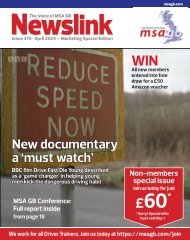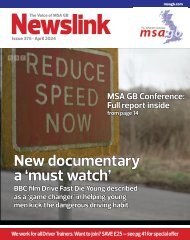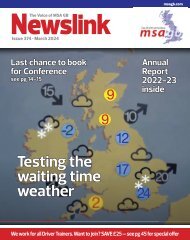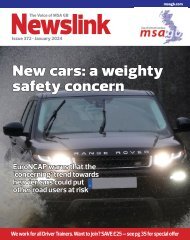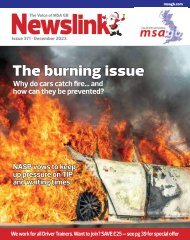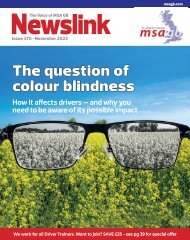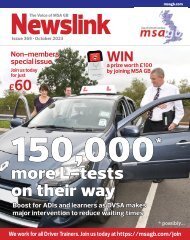Newslink
Motor Schools Association membership magazine, driver training and testing, ADIs, road safety
Motor Schools Association membership magazine, driver training and testing, ADIs, road safety
Create successful ePaper yourself
Turn your PDF publications into a flip-book with our unique Google optimized e-Paper software.
News<br />
Equine fatalities on the rise as<br />
drivers struggle to handle horses<br />
Colin Lilly<br />
Editor, MSA <strong>Newslink</strong><br />
Following a presentation at the MSA GB<br />
National Training Day at Nottingham in<br />
2019 by Alan Hiscox, director of Safety<br />
at the British Horse Society (BHS), there<br />
have been a number of follow-up stories<br />
in <strong>Newslink</strong> on the particular challenge<br />
presented by horses on the roads.<br />
In November 2020, in conjunction with<br />
the Brake Road Safety Week, the BHS<br />
published the statistics for 2019-20 of<br />
traffic incidents involving horses and<br />
other road users. That year saw 1,037<br />
incidents involving horse and other road<br />
users, an increase of 23 per cent on the<br />
previous year. Sadly these resulted in the<br />
deaths of 80 horses and one person,<br />
with a further 136 horses injured along<br />
with 135 people.<br />
Further analysis revealed that:<br />
n 40 per cent of the incidents involved<br />
a vehicle travelling too fast.<br />
n 81 per cent involved a vehicle<br />
travelling too close.<br />
n 43 per cent riders reported road rage<br />
and abuse.<br />
Looking at these figures the survey<br />
showed that 203 incidents were in the<br />
south west. More than half, 104, were in<br />
Devon, and they involved one rider and<br />
33 horse fatalities.<br />
These figures are particularly worrying<br />
in a county like Devon which is<br />
principally a rural county with active<br />
farms, stables and riders; it is a county<br />
where animals should be anticipated as<br />
part of the environment.<br />
Nationally, a number of incidents<br />
involved semi-feral ponies such as those<br />
found on Dartmoor, Exmoor and in the<br />
New Forest. These covered 127 of the<br />
incidents – well over 10 per cent. It is<br />
worth noting that two of the named<br />
national parks are in Devon.<br />
In December four ponies were killed in<br />
a collision in the New Forest on Roger<br />
Penny Way, a road with a history for<br />
such collisions. It is thought that the<br />
ponies had wandered on to the 40mph<br />
road to lick salt from the freshly gritted<br />
road. The vehicle involved, a Land Rover<br />
Discovery, was severely damaged.<br />
Earlier in the month three donkeys had<br />
been killed on the same stretch of road<br />
which is known locally as a blackspot for<br />
similar incidents.<br />
The New Forest is the largest remaining<br />
area of land where ‘commoners’ can<br />
allow their animals to roam freely on the<br />
heathland; this includes cattle, ponies<br />
and donkeys.<br />
The New Forest National Park<br />
Authority (NNPA) reported that in 2019,<br />
58 animals were killed and 32 injured; it<br />
added that as the animals roam<br />
throughout the area 24 hours a day,<br />
motorists should anticipate their<br />
presence.<br />
But do drivers take the issue seriously?<br />
Earlier this year Warwickshire Police held<br />
a campaign highlighting riders being two<br />
abreast. Many drivers claim this is not<br />
allowed, despite the Highway Code<br />
suggesting that this is sensible if one<br />
horse/rider is accompanying a young or<br />
inexperienced horse or rider.<br />
There has been talk recently about the<br />
need to train drivers on rural roads where<br />
possible. Even if this cannot be factored<br />
into your training plans because of<br />
distance, discussions with your pupils<br />
about some of the potential hazards<br />
peculiar to a rural environment should be<br />
an absolute must.<br />
ADIs asked to shape the future of autonomous cars<br />
A major new survey has been launched<br />
to assess how motorists will accept and<br />
use connected, co-operative and<br />
autonomous and automated transport in<br />
the future.<br />
IAM RoadSmart is part of this<br />
EU-funded research project, which is<br />
called Drive2theFuture. The outcome of<br />
the survey will also assist the developers<br />
of these technologies to understand and<br />
meet users’ needs and wants.<br />
Driver trainers’ views are very<br />
important to this project, and IAM<br />
RoadSmart has asked MSA GB<br />
members to complete a short online<br />
survey which will allow the consortium<br />
to consider their views going<br />
forward. The survey is being circulated<br />
to driver trainers and driving schools<br />
across Europe.<br />
More about Drive2 the Future ....<br />
Drive2the<br />
Future<br />
To take part in survey, click here<br />
Drive2 the<br />
Future<br />
Survey<br />
12<br />
NEWSLINK n JANUARY 2021




